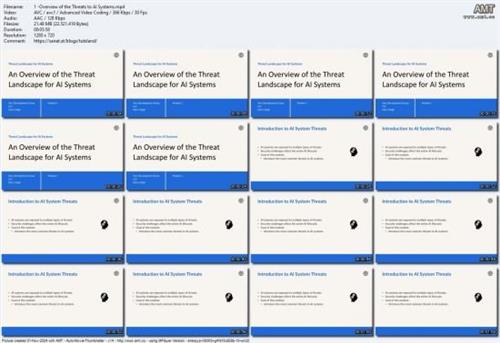- Thread Starter
- #1
Threat Landscape of AI Systems

What you'll learn
Learn the fundamental ethical principles and guidelines that govern AI development and deployment.
Explore how to integrate fairness, transparency, accountability, and inclusivity into AI systems.
Gain the ability to recognize various security risks and threats specific to AI systems, including adversarial attacks and data breaches.
Develop strategies and best practices for mitigating these risks to ensure the robustness and reliability of AI models.
Understand the key regulatory frameworks and data protection laws relevant to AI, such as GDPR and CCPA.
Learn how to design and implement AI systems that comply with these regulations to protect user privacy and avoid legal penalties.
Explore advanced techniques such as differential privacy, federated learning, and homomorphic encryption to safeguard sensitive data.
Learn how to apply these methods to balance the need for data utility and privacy in AI applications.
Requirements
Familiarity with key concepts, terminology, and basic principles of AI and machine learning.
Understanding of how AI models are trained, validated, and deployed.
Basic knowledge of data collection, preprocessing, and analysis techniques.
Understanding of fundamental cybersecurity principles and practices.
Awareness of common security threats, such as malware, phishing, and data breaches.
Ability to analyze complex problems and think critically about potential solutions.
Description
Artificial intelligence (AI) systems are increasingly integrated into critical industries, from healthcare to finance, yet they face growing security challenges from adversarial attacks and vulnerabilities. Threat Landscape of AI Systems is an in-depth exploration of the security threats that modern AI systems face, including various types of attacks, such as evasion, poisoning, model inversion, and more. This course series provides learners with the knowledge and tools to understand and defend AI systems against a broad range of adversarial exploits.Participants will delve into:Evasion Attacks: How subtle input manipulations deceive AI systems and cause misclassifications.Poisoning Attacks: How attackers corrupt training data to manipulate model behavior and reduce accuracy.Model Inversion Attacks: How sensitive input data can be reconstructed from a model's output, leading to privacy breaches.Other Attack Vectors: Including data extraction, membership inference, and backdoor attacks.Additionally, this course covers:Impact of Adversarial Attacks: The effects of these threats on industries such as facial recognition, autonomous vehicles, financial models, and healthcare AI.Mitigation Techniques: Strategies for defending AI systems, including adversarial training, differential privacy, model encryption, and access controls.Real-World Case Studies: Analyzing prominent examples of adversarial attacks and how they were mitigated.Through a combination of lectures, case studies, practical exercises, and assessments, students will gain a solid understanding of the current and future threat landscape of AI systems. They will also learn how to apply cutting-edge security practices to safeguard AI models from attack.
Who this course is for
Individuals preparing for careers in AI, machine learning, or cybersecurity who want to ensure they are well-versed in ethical and security best practices.
Data scientists, machine learning engineers, and AI researchers looking to deepen their understanding of AI ethics and security practices.
Professionals who design, develop, and deploy AI models and need to ensure these systems are ethical, secure, and compliant with regulations.
Cybersecurity professionals aiming to expand their knowledge to include the unique challenges and threats associated with AI systems.
Professionals tasked with ensuring organizational compliance with data protection laws and regulations.
Those responsible for implementing privacy-preserving techniques and maintaining the confidentiality and integrity of data used in AI systems.
Leaders who need to understand the ethical implications and security requirements of AI to guide strategic decision-making and policy development.
Individuals working in ethics committees, compliance departments, or regulatory bodies who need to evaluate and oversee AI projects.
Professionals who assess the ethical impact of AI technologies and ensure they align with ethical guidelines and regulatory standards.
Academics studying AI, ethics, cybersecurity, or related fields who wish to incorporate ethical and security considerations into their research.
Researchers focusing on developing new methodologies and frameworks for ethical and secure AI.
Graduate students or advanced undergraduates in computer science, data science, cybersecurity, or related fields looking to specialize in AI ethics and security.
Homepage:

Say "Thank You"
rapidgator.net:
ddownload.com:

Published 11/2024
MP4 | Video: h264, 1280x720 | Audio: AAC, 44.1 KHz, 2 Ch
Language: English | Duration: 1h 16m | Size: 355 MB
Navigating Security Threats and Defenses in AI Systems
MP4 | Video: h264, 1280x720 | Audio: AAC, 44.1 KHz, 2 Ch
Language: English | Duration: 1h 16m | Size: 355 MB
Navigating Security Threats and Defenses in AI Systems
What you'll learn
Learn the fundamental ethical principles and guidelines that govern AI development and deployment.
Explore how to integrate fairness, transparency, accountability, and inclusivity into AI systems.
Gain the ability to recognize various security risks and threats specific to AI systems, including adversarial attacks and data breaches.
Develop strategies and best practices for mitigating these risks to ensure the robustness and reliability of AI models.
Understand the key regulatory frameworks and data protection laws relevant to AI, such as GDPR and CCPA.
Learn how to design and implement AI systems that comply with these regulations to protect user privacy and avoid legal penalties.
Explore advanced techniques such as differential privacy, federated learning, and homomorphic encryption to safeguard sensitive data.
Learn how to apply these methods to balance the need for data utility and privacy in AI applications.
Requirements
Familiarity with key concepts, terminology, and basic principles of AI and machine learning.
Understanding of how AI models are trained, validated, and deployed.
Basic knowledge of data collection, preprocessing, and analysis techniques.
Understanding of fundamental cybersecurity principles and practices.
Awareness of common security threats, such as malware, phishing, and data breaches.
Ability to analyze complex problems and think critically about potential solutions.
Description
Artificial intelligence (AI) systems are increasingly integrated into critical industries, from healthcare to finance, yet they face growing security challenges from adversarial attacks and vulnerabilities. Threat Landscape of AI Systems is an in-depth exploration of the security threats that modern AI systems face, including various types of attacks, such as evasion, poisoning, model inversion, and more. This course series provides learners with the knowledge and tools to understand and defend AI systems against a broad range of adversarial exploits.Participants will delve into:Evasion Attacks: How subtle input manipulations deceive AI systems and cause misclassifications.Poisoning Attacks: How attackers corrupt training data to manipulate model behavior and reduce accuracy.Model Inversion Attacks: How sensitive input data can be reconstructed from a model's output, leading to privacy breaches.Other Attack Vectors: Including data extraction, membership inference, and backdoor attacks.Additionally, this course covers:Impact of Adversarial Attacks: The effects of these threats on industries such as facial recognition, autonomous vehicles, financial models, and healthcare AI.Mitigation Techniques: Strategies for defending AI systems, including adversarial training, differential privacy, model encryption, and access controls.Real-World Case Studies: Analyzing prominent examples of adversarial attacks and how they were mitigated.Through a combination of lectures, case studies, practical exercises, and assessments, students will gain a solid understanding of the current and future threat landscape of AI systems. They will also learn how to apply cutting-edge security practices to safeguard AI models from attack.
Who this course is for
Individuals preparing for careers in AI, machine learning, or cybersecurity who want to ensure they are well-versed in ethical and security best practices.
Data scientists, machine learning engineers, and AI researchers looking to deepen their understanding of AI ethics and security practices.
Professionals who design, develop, and deploy AI models and need to ensure these systems are ethical, secure, and compliant with regulations.
Cybersecurity professionals aiming to expand their knowledge to include the unique challenges and threats associated with AI systems.
Professionals tasked with ensuring organizational compliance with data protection laws and regulations.
Those responsible for implementing privacy-preserving techniques and maintaining the confidentiality and integrity of data used in AI systems.
Leaders who need to understand the ethical implications and security requirements of AI to guide strategic decision-making and policy development.
Individuals working in ethics committees, compliance departments, or regulatory bodies who need to evaluate and oversee AI projects.
Professionals who assess the ethical impact of AI technologies and ensure they align with ethical guidelines and regulatory standards.
Academics studying AI, ethics, cybersecurity, or related fields who wish to incorporate ethical and security considerations into their research.
Researchers focusing on developing new methodologies and frameworks for ethical and secure AI.
Graduate students or advanced undergraduates in computer science, data science, cybersecurity, or related fields looking to specialize in AI ethics and security.
Homepage:
Screenshots

Say "Thank You"
rapidgator.net:
You must reply in thread to view hidden text.
ddownload.com:
You must reply in thread to view hidden text.
